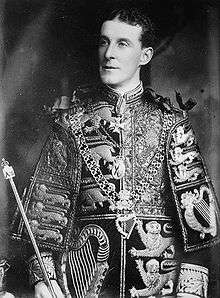Arthur Vicars

Sir Arthur Vicars, KCVO (27 July 1862 – 14 April 1921) was an English-born genealogist and heraldic expert who spent his adult life in Ireland. He was appointed Ulster King of Arms in 1893, but was removed from the post in 1908 following the theft of the Irish Crown Jewels in the previous year. He was killed by the IRA in 1921 during the Irish War of Independence.
Antiquarian and expert in heraldry
Arthur Edward Vicars was born on 27 July 1862 in Leamington Spa, Warwickshire, and was the youngest child of Colonel William Henry Vicars of the 61st Regiment of Foot and his wife Jane (originally Gun-Cunninghame). This was his mother's second marriage, the first being to Pierce O'Mahony by whom she had two sons. Arthur was very attached to his Irish half-brothers and spent much time at their residences. On completing his education at Magdalen College School, Oxford and Bromsgrove School he moved permanently to Ireland.
He quickly developed an expertise in genealogical and heraldic matters and made several attempts to be employed by the Irish heraldic administration of Ulster King of Arms, even offering to work for no pay.
In 1891 he was one of the founder members of the County Kildare Archaeological Society, and remained its honorary secretary until his death.
He first attempted to find a post in the Office of Arms when in 1892 he applied unsuccessfully for the post of Athlone Pursuivant on the death of the incumbent, Bernard Louis Burke. In a letter dated 2 October 1892 Vicars's half-brother Peirce Mahony wrote that Sir Bernard Burke, Ulster King of Arms, was dying and urged him: "You should move at once." [1] Burke died in December 1892, and Vicars was appointed to the office by Letters Patent dated 2 February 1893. In 1896 Arthur Vicars was knighted, in 1900 he was appointed Commander of the Royal Victorian Order (CVO) and in 1903 he was elevated to Knight Commander of the order (KCVO). He was also a fellow of the Society of Antiquaries and a trustee of the National Library of Ireland. [2]
In 1897 Vicars published An Index to the Prerogative Wills of Ireland 1536 -1810, a listing of all persons in wills proved in that period. This work became very valuable to genealogists after the destruction of the source material for the book in 1922 when the Public Record Office at the Four Courts was destroyed at the start of the Irish Civil War.
Theft of the Irish Crown Jewels

Vicars' career was very distinguished until 1907 when it was hit by the scandal of the theft of the Irish Crown Jewels. As Registrar of the Order of St Patrick, Vicars had custody of the insignia of the order, also known as the "crown jewels". They were found to be missing on 6 July, and a Crown Jewel Commission was established in January 1908 to investigate the disappearance. Vicars, and his barrister Tim Healy, refused to attend the commission's hearings. The commission's findings were published on 25 January 1908, and Vicars was dismissed as Ulster five days later.
On 23 November 1912, the Daily Mail published serious false allegations against Vicars. The substance of the article was that Vicars had allowed a woman reported to be his mistress to obtain a copy to the key to the safe and that she had fled to Paris with the jewels. In July 1913 Vicars successfully sued the paper for libel, who admitted that the story was completely baseless and that the woman in question did not exist. Vicars was awarded damages of £5,000.[3]
Vicars left Dublin and moved to Kilmorna, near Listowel, County Kerry, the former seat of one of his half-brothers. He married Gertrude Wright in Ballymore, County Wicklow on 4 July 1917.[4] He continued to protest his innocence until his death, even including bitter references to the affair in his will.
His death
In May 1920 up to a hundred armed men broke into Kilmorna House and held Vicars at gunpoint while they attempted to break into the house's strongroom. On 14 April 1921, he was taken from Kilmorna House, which was set alight, and shot dead in front of his wife. According to the communique issued from Dublin Castle, thirty armed men took him from his bed and shot him, leaving a placard around his neck denouncing him as an informer.[5] On 27 April, as an official reprisal, four shops were destroyed by Crown Forces in the town of Listowel. The proclamation given under Martial law and ordering their demolition also stated:
For any outrage carried out in future against the lives or property of loyalist officials, reprisals will be taken against selected persons known to have rebel sympathies, although their implication has not been proved.[6]
Vicars was buried in Leckhampton, Gloucestershire on 20 April.[7] His wife died in Somerset in 1946.[8]
Armorial bearings
 |
|
Sources
- Royal Roots, Republican Inheritance, The Survival of the Office of Arms, Susan Hood, Dublin 2002
References
| Wikimedia Commons has media related to Arthur Vicars. |
- ↑ "Sale catalogue of Rare Books, Manuscripts & Watercolours" (PDF). Fonsie Mealy Auctioneers. 15 December 2015. p. 45, lot 486. Retrieved 6 January 2016.
- ↑ "Armorial Families", Fox-Davies (5th Ed.), Edinburgh: T.C. & E.C. Jack, 1905, p.1405
- ↑ "The Irish Crown Jewels – Sir Arthur Vicars libelled,” The Times, 5 July 1913.
- ↑ "Forthcoming Marriages,” The Times, 29 June 1917
- ↑ "Murder of Sir A. Vicars,” The Times, 15 April 1921
- ↑ “Irish Bulletin's Reply to Official Statements,” Freeman's Journal, June 7, 1921, p. 3.
- ↑ "Funerals,” The Times, 19 April 1921
- ↑ "Arthur Vicars". Oxford Dictionary of National Biography.
| Heraldic offices | ||
|---|---|---|
| Preceded by Sir John Bernard Burke |
Ulster King of Arms 1893–1908 |
Succeeded by Sir Neville Rodwell Wilkinson |